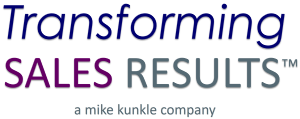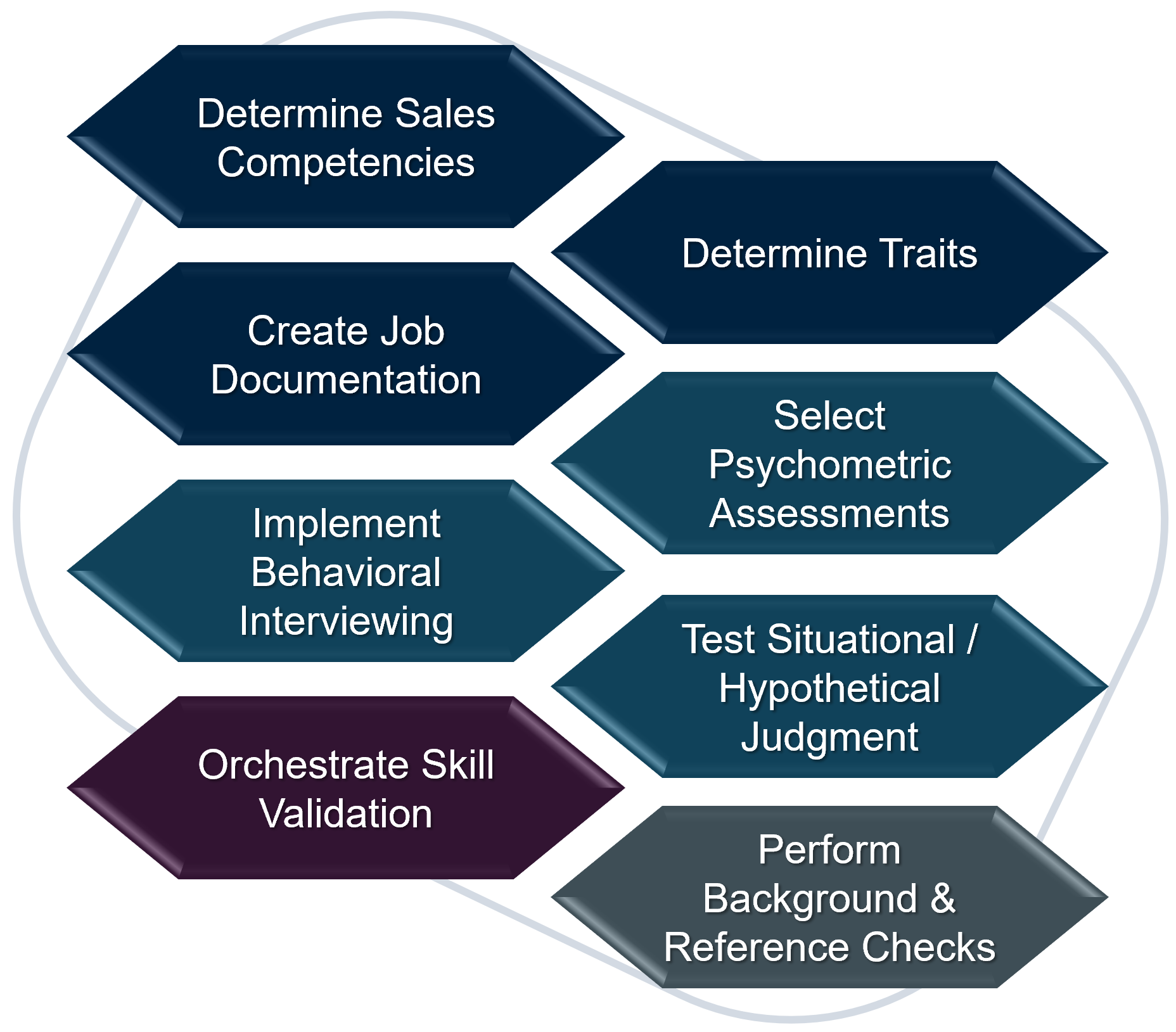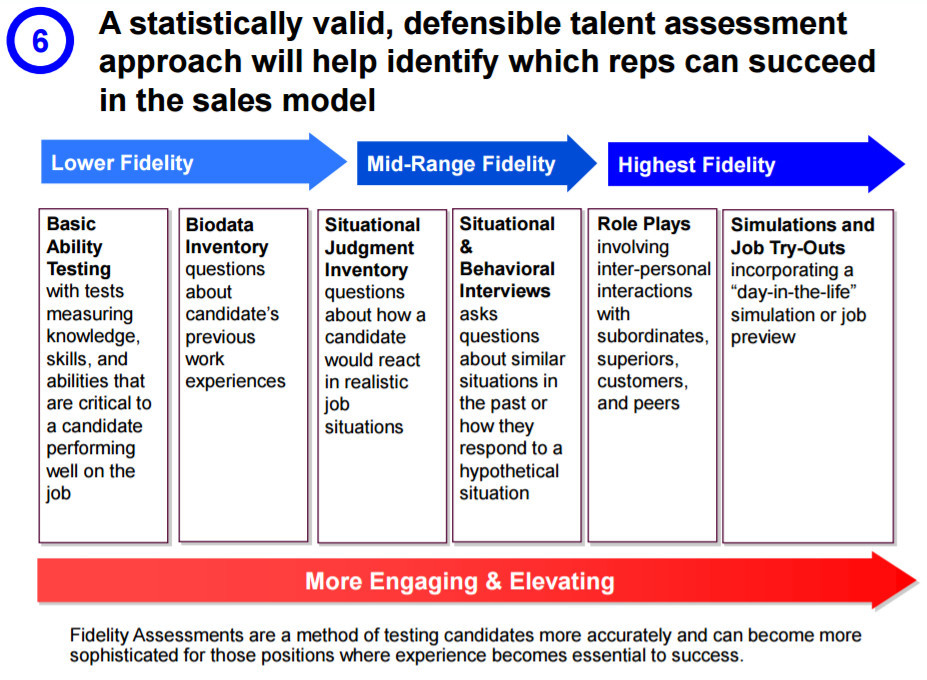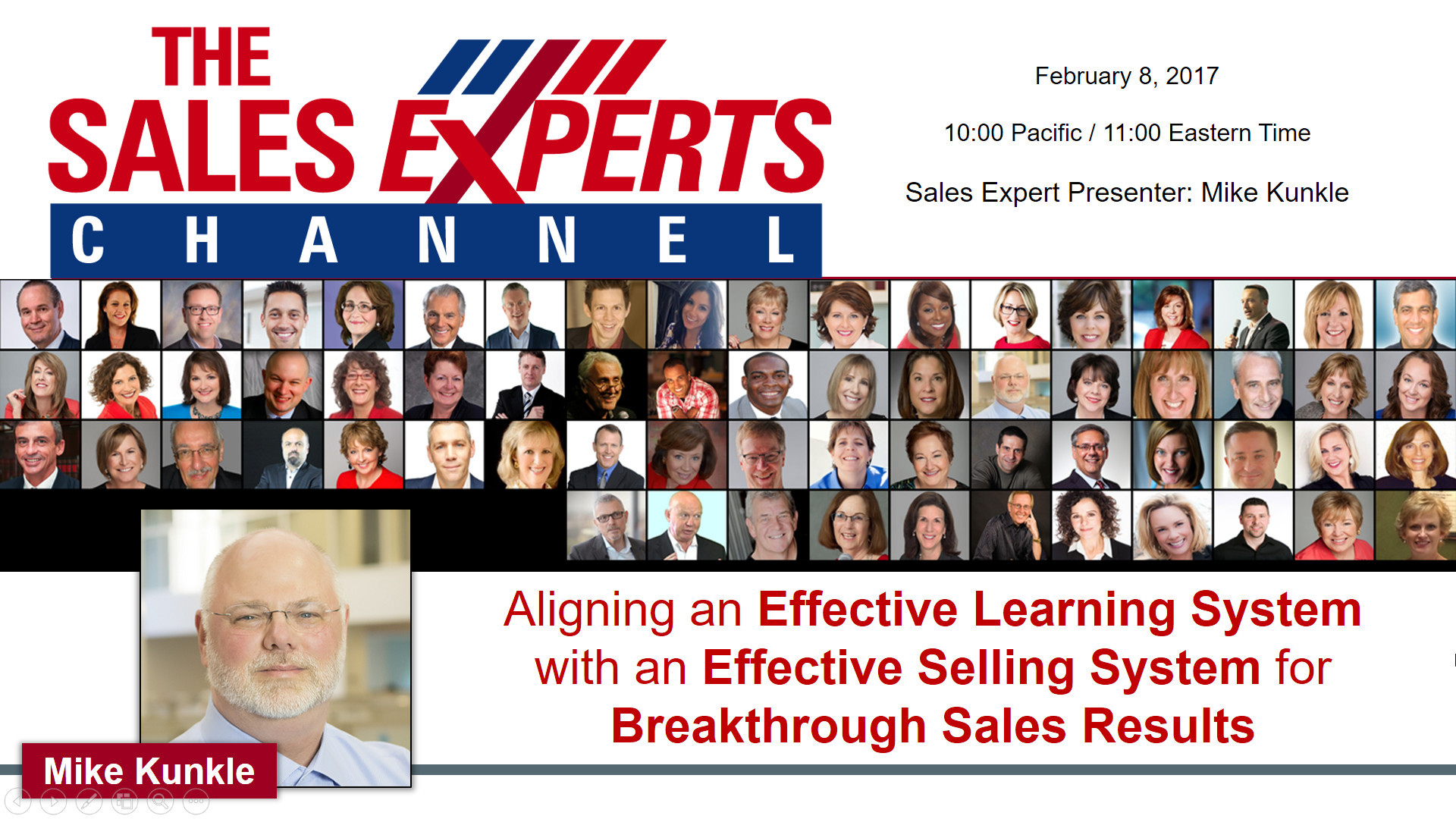Transform Your Sales Results with a Systems Approach – Part 2: Sales Selection
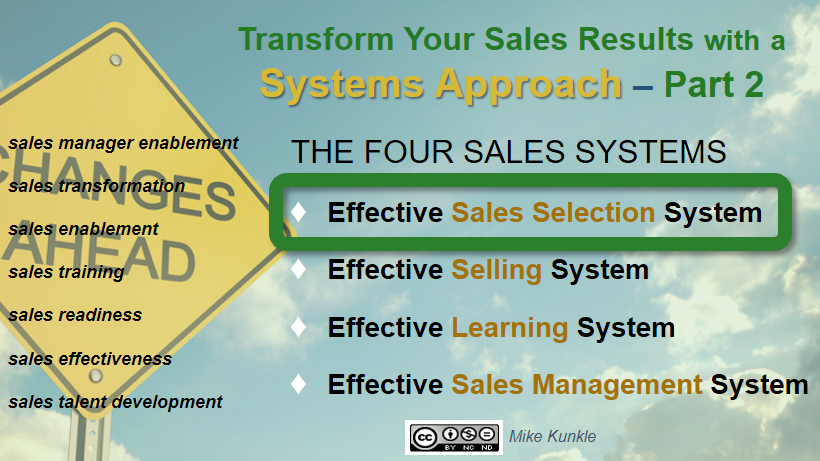
In part 1 of this series, I wrote about the challenges we face in the sales profession and shared my opinion that…
…the solution to our current sales problems – and the vehicle for transforming your sales results – is a Systems Approach to Sales.
There are many sales systems, but the four I prioritize as the “movers and shakers” are:
The Four Sales Systems
- Sales Selection System
- Sales Support System
- Sales Learning System
- Sales Management System
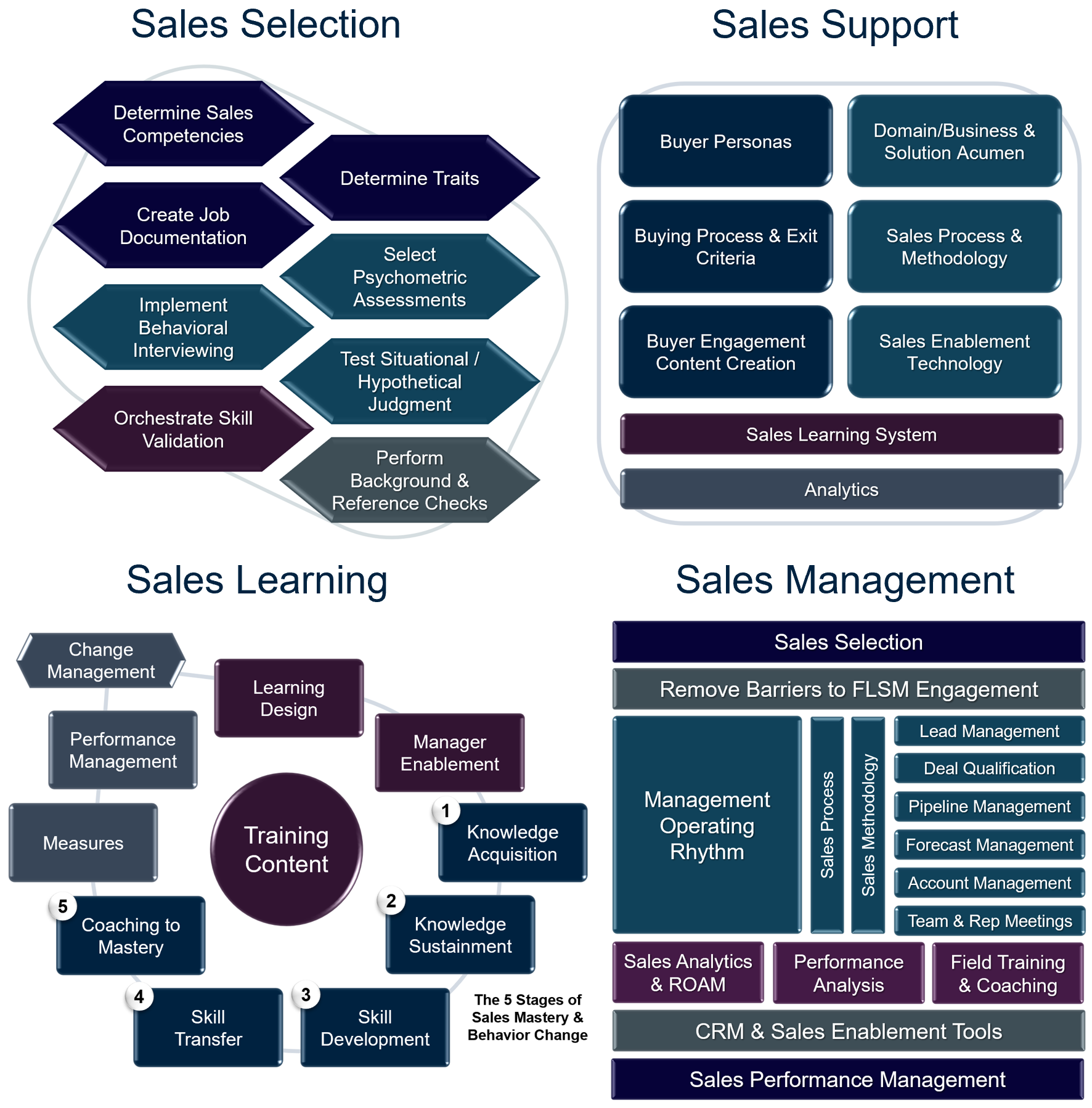
Today, I’m going to dive into the system that lays the foundation for all of the others to produce the best results… an effective Sales Selection System.
Thoughts about Sales Selection
Can you pick your next sales team (both reps and managers) or individual hire, and get it right? What percent of the time?
Allow me to get passionate (aka, rant) here for a moment. This is the foundation on which everything else builds. It’s Jim Collins’ famous advice from his book, Good to Great, where he wrote, “Get the right people on the bus, the wrong people off the bus, and the right people in the right seats.” The other systems are powerful. They help you maximize the potential of your talent. In fact, great systems can help you get above-average performance from otherwise average players, which is why I build systems. I’m fond of quoting the late Geary Rummler…
“If you pit a good performer against a bad system, the system will win almost every time.”
Geary Rummler , founding partner of Performance Design Lab and co-founder of The Rummler-Brache Group
So, it’s obvious I’m a systems guy. A bad system will drag down good performers. But hear this clearly. If you don’t have the right players in the right roles, the other three systems simply won’t produce the maximum possible results. Any one system will do something for you. Combine them and it gets even better. But you simply can’t over-compensate for the lack of appropriate talent.
- If you want to improve your sales onboarding and decrease ramp-up time while increasing average new-hire production — the first step of effective sales onboarding is to hire the right talent for the right roles.
- If you want to increase the performance of an entire sales team, there are a lot of things you can do, but the single biggest is to put the right manager in place (hiring and promoting sales managers effectively).
We all know this, right? Heads nod around board room tables whenever I say stuff like this. So here’s the big question…
IF WE ALL KNOW THIS, WHY DON’T PUT MORE ENERGY INTO SELECTING THE RIGHT TALENT?!?
Yeah, okay, I’m a little excitable about this. I’ve seen the massive impact it can make. I’ve seen first-year, new-hire churn nose-dive from 75% to 25%. I’ve seen a team with solid B players, but no hardcore A players, double their average monthly production in six months’ time with the right (replacement) sales manager in place. In both examples, there were other factors and initiatives in play, but they wouldn’t have worked as well without the right talent in place.
And conversely, twice in my career I’ve had reputable, well-qualified, highly-experienced vendors do complete talent audits of the sales force (reps and managers), with approved job profiles, competency measurements, psychometric assessments, calibrated reporting, and more. Leaders were engaged throughout the process and signed-off on each step. Everyone was educated about how the process and tools worked and what they would tell us. And when the final reports rolled in, senior leaders didn’t like what they were being told, and the reports got stuck on the shelf. Think results improved? In both cases, eventually, there were layoffs.
For those of you who are now clapping, laughing, or crying, and may actually want to do something differently, here’s a better way to approach sales selection.
Elements of a Sales Selection System
Determine Sales Competencies:
Determine the competencies (skills and behaviors) needed for sales success, in your company, for your various roles. There will be overlap between roles and other things that may be indigenous, but list them all and create a library from which to pull. This is the foundation for everything else in this system. You need to get this right, and there are experts who can help.
- ATD has their updated World-Class Sales Competency Model.
- SiriusDecisions has one for members called The SiriusDecisions Sales Competency Definition Tool and I’m sure some other analysts offer models to members.
- Sales consulting firms like Sales Benchmark Index, Alexander Group and ZS Associates would be great partners (those are links to posts and their work, not just their websites).
- Accenture consults on this, as does AON (great deck from AON and the Sales Management Association, see section 6), and I’m sure the other management consulting firms do the same (like McKinsey, Deloitte, Bain, PwC).
- Dave Brock has a really good one that he shares for the price of a book purchase – see this page for details.
- My friend Cheryl Lasse of SkillDirector (see this webcast) who did a lot of work with GE when I was there (and who has a great online tool you can explore) can help you build a competency model and assess skill levels over time (and tie training courses to them).
- Some assessment vendors also use competency-based approaches and can help you select competencies by role, which their assessments will then support.
- And there are plenty of other competency experts out there. Some sales training firms do this work. See this report from Richardson on Aligning Sales Competencies in Learning and Development and this page from RAIN Group on core competencies for sellers.
I added plenty of resources here because of the importance of the foundation of defining sales competencies by role. I won’t do that everywhere else, or this will be an ebook.
Determine Traits:
Determine the traits (aka attributes or characteristics; personality) required to support the competencies and thrive in the various, challenging roles. (In addition to high skill levels, selling requires certain mindsets and traits — it’s more like being an Olympic athlete than an accountant.) These may also vary by role. Create a library, as with your competencies.
Create Job Documentation:
By sales role, create a job description and job specifications or job profile, especially documenting the tasks required for success and slotting in the competencies and traits you defined, to build the requirements for each role.
Select Psychometric Assessments:
Find statistically-validated psychometric assessments that can assess the competencies and traits.
Approaches vary, but since I’m a believer in sales nuance, I prefer assessing and profiling top-producers inside a company to find more like them, rather than assessing against a stock “sales profile.” Even better, if possible, profile the top, bottom and middle performers, and look for statistically-valid differences between top and middle performers and the top and bottom (helps you know what patterns to avoid as much as what patterns to prefer). If you have a small sales force, you may not be able to do quite as much valid analysis of your own data, and may need to reply more on the assessment company’s experience, until you build your own data by hiring more and correlating to performance.
Some vendors sell their assessment as a “weed out” tool. Most will advise you that the assessment should be weighed as a third of the decision process. I prefer to use the assessment to inform the interview and the final decision, more than a weed out factor (or perhaps you might weed out some, based on how far a candidate scores outside your ideal).
Whatever you do, be consistent. Other than validity studies, that’s what keeps it legal and ethical.
- Note: I don’t have a Ph.D in psychometrics, but from the research I’ve done, I prefer normative assessments to ipsative. Those selling ipsative assessments obviously disagree with me, so do your own research, talk to experts, and find the right approach for you. Don’t let perfect be the enemy of good – there is no perfect assessment. Demand validity and “settle” for excellence. Any statistically-validated approach will likely be far better than what you’re doing today, especially if weaved in with these other methods.
For those interested in exploring assessments or just learning more, here are some good, non-partisan educational resources:
Implement Behavioral Interviewing:
Establish behavioral interview questions to gauge whether candidates possess these competencies and traits and can provide examples of such from their past (past behavior is the best predictor of future behavior). Establish a way to take notes and score answers, perhaps against a best-case answer. Learn how to conduct a behavioral interview and guide candidates to provide detailed stories and examples through effective questioning. A good framework is SAR: Ask the candidate to give you an example of a time when they [fill in the blank with the behavior you want to assess). Guide them to provide the Situation (which relates to the competency or trait you’re assessing), the Action they took, and the Result they got (and possibly, what they learned from it).
Test Situational/Hypothetical Judgment:
Establish some challenging hypothetical scenarios (perhaps built from real case studies as your company) and prepare questions and best-case responses to assess candidates’ answers against.
Orchestrate Skill Validation:
Create role plays or simulations (sims) to validate that candidates can actually demonstrate the skills they verbally tell you they have. Sims can be low-tech role plays (please don’t do “sell me this pen”) or there are high-tech options with virtual coaching solutions, virtual role plays, or full-blown, online, branched simulations with scoring. Your mileage may vary, but role plays work. Hiring an SDR rep or field rep who will prospect? Have them email you and call you. Give them a real or simulated case study or prospect, and see what they can do (calling you, not the real prospect). Use your imagination here, but keep the tasks and sims as real-life as possible, and see how candidates handle themselves.
Perform Background & Reference Checks:
For finalists, do background checks (employment, education, criminal, and as desired, drug testing, following HR and Legal guidance) and reference checks. This is just common sense, but since common sense isn’t always common practice, don’t leave this stuff out.
Sidebar – Consider Topgrading for Sales:
This is its own system by Brad Smart, not mine, but it deserves the mention. The Topgrading for Sales system and book was co-authored by Brad and Greg Alexander, who used Topgrading for Sales very successfully at EMC, before he started Sales Benchmark Index (SBI).
Putting It All Together
This is where you weave together the above elements (or the ones you choose) so that there is a structured, logical process for executing. (Get consultant advice if you need it). In some companies, especially where each hire was critical, I have implemented all the elements. In others, I selected the combination that made the most sense for the company and culture.
In the link above from AON/Sales Management Association, this slide provides good perspective (and includes some things my system does not, like biodata, which some companies and industries, like insurance sales, do use effectively):
Things to Consider
Many companies use behavioral interviewing (or so they say; I’ve interviewed at some where they said they did, yet no one asked me a single behavioral question) but have no plan for how various interviewers will split up the interview questions or no plan to calibrate their ratings of the candidate at the end (which would require using questions consistently and actually taking notes of the responses and rating them). Have a plan.
With some assessment products, if you use the psychometric assessments before the interview, the assessment will provide behavioral questions to help you dig deeper into an area where the candidate did not fit the profile as closely as desired.
A Side Note on Sourcing: I once developed a selection system for a business that was highly effective, but we ran into a roadblock shortly after implementation. After we developed the ideal profile, there wasn’t a single candidate in the pipeline who was remotely close to qualifying. Keep in mind that few candidates are an exact match. People are, well, human. There’s a give and take in hiring. If the person can learn, is willing to, and will accept coaching, you can teach the right person new skills. For traits, you need to be a bit more selective, but also accept some shortfalls than can be compensated for in other ways or coached. In the above case, we didn’t have anyone remotely close to the new profile. We had learned to hire right, but now needed to source right (for the new hiring profile). For that, we worked very closely with Recruiting and HR, and figured things out. Interesting lesson though.
I can’t run through every combination or scenario, but these are the sorts of things you need to think through. An experienced consultant or vendor partner can help with this, and establish a flow and process. While putting a selection system in place like this seems daunting, it’s the research, project work, decisions, and implementing a new process that is the hard part. Once you have the elements in place and a sensible process, and have people trained on how to use the system, you’ll build momentum quickly, as people start to see it working. When you consider how absolutely critical it is to have the right sales talent, and the costs of turnover, failed reps, or the opportunity loss of barely-successful who usually miss quota, you’ll be glad you invested the time and energy to hire right.
Next time, we’ll talk about building an Effective Selling System.
Author Note:
You can find Part 1 here, Part 2 here, Part 3 here, and Part 4 here and Part 5 here.
Related Webinar – Watch the On-demand Replay!
Aligning an Effective Learning System with an Effective Selling System for Breakthrough Sales Results
I did a webinar on 2 of the 4 systems on The Sales Experts Channel via BrightTALK. You can watch it here.
_________________________________________________
As usual, this is what I think. More importantly… What do YOU think?
I’d enjoy hearing your thoughts and experiences in the comments section. If you enjoy this post, please feel free to share it with others.
Thanks for reading, be safe out there, and by all means… let’s continue to elevate our sales profession and evolve, elevate and professionalize the Sales Enablement function.
Mike Kunkle
Let’s get connected:
- This Blog: https://www.mikekunkle.com/blog
- SMM Connect Webinars: http://bit.ly/STSTonSMM
- BrightTALK Webinars: http://bit.ly/TheSalesExpertsChannel
- LinkedIn Publisher: http://bit.ly/MikeKunkleLIPublisher
- LinkedIn Profile: http://www.linkedin.com/in/mikekunkle
- SlideShare: http://www.slideshare.net/MikeKunkle
- Twitter: https://twitter.com/mike_kunkle
_____________________________________________________________
sales transformation | sales force transformation | sales training | sales talent development | sales enablement | sales force enablement | sales manager enablement | sales readiness | sales effectiveness | sales optimization | sales operations
